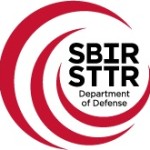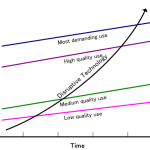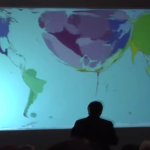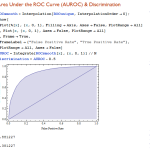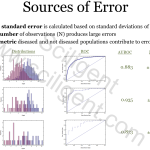Source: Eurekalert, November 29, 2017 Researchers at Caltech used directed evolution method, where enzymes are evolved in a lab to perform desired functions, to coax the bacteria into making boron-containing compounds. They mutated the DNA that encodes the protein and then put the mutated DNA sequences into thousands of bacterial cells. The DNA of successful mutant proteins was then mutated again, and the cycle was repeated until the bacteria making the proteins were highly proficient at assembling the boron-carbon compounds. Their final bacterial creations were up to 400 times more productive than synthetic chemical processes used for the same reaction. […]
Single-photon detector can count to 4
Source: Nanowerk December 15,2017 A team of researchers in the US (Duke University, Ohio State University, industry) used the superconducting nanowire single-photon detector (SNSPD) method to show multi-photon detection indicating number resolution up to four photons. They paid special attention to the specific shape of the initial spike in the electrical signal to correctly count at least four photons traveling together in a packet. Photon-number-resolution is very useful for a lot of quantum information/communication and quantum optics experiment; it could greatly increase the speed of quantum encryption techniques… read more. Open Access TECHNICAL ARTICLE
Creating surfaces that repel water and control its flow
Science Daily, December 13, 2017 To gain better control over the flow of water on superhydrophobic materials, scientists have been etching paths into coatings for the liquid to follow. And although water will take the designated path, it can leave behind a wet trail as the rolling droplets have a different contact angle at the front and back. An international team of researchers (China, US – UMass Amherst) has developed a technique to make the tracks hydrophobic which is critical for keeping water droplets’ spherical shape and minimizing the difference in the front and back contact angles. Testing showed that […]
What does “Sciligent” mean?
Rather than write about it, I made the video below to describe where it comes from.Now, as to the pronunciation, the first “i” is long. as in SAI – ligent, because the “sci” comes from “science” which also has a long “i”
DoD/SBIR 14.2 Topics Announced
The latest batch of SBIR’s were announced last week. You can view them all at the official site and also sign up there for e-mail announcements. SITIS Topic # Program Solc Agency Title A14-081 SBIR 14.2 Army Innovative Situational Awareness and Decision Making Algorithms on Open Architecture System-on-Module Q&A A14-082 SBIR 14.2 Army Projectile Energy Devices A14-083 SBIR 14.2 Army Scalable Design Method for Reconfigurable Canard Actuation Systems A14-084 SBIR 14.2 Army Hybrid Projectile Components Miniaturization A14-085 SBIR 14.2 Army Hemispheric Imaging System A14-086 SBIR 14.2 Army Room Temperature Ballistic Testing Backing Material A14-087 […]
Disruptive Innovation Explained by Clayton Christensen
When talking to clients and colleagues the term “disruptive innovation” will often be used. In fact, this is popular enough that it appears in government solicitations. Since the term was originated by Clayton Christensen several years ago, it has taken on a variety of different meanings. It is certainly overused, but I often wonder if it is being misused. It is important to recognize that the term comes directly from Christensen’s Disruptive Innovation Theory. And although it has since strayed from this specific definition, it is important to keep its past in mind.Here is the original definition from Christensen:”A disruptive […]
The Three Technology Drivers (according to Neil Tyson)
Astrophysicist Neil deGrasse Tyson, outlines the only technology drivers that have been behind big investment projects from the construction of the pyramids to the exploration of the new world to the Manhattan Project. Making extraordinary investments in science and technology requires convincing the “checkwriters” (as he describes them) to invest not for reasons like intellectual curiosity or adventure but for very different reasons. In his survey, despite expecting to find hundreds of reasons, he only found three: The War/Defense/Fear Driver Economic/Promise of Wealth/Greed Driver Tribute to Deity/Royalty/Adoration Check out the following video where he speaks at length about these: His […]
Receiver Operating Characteristics (ROC) Analysis (Part 3 of 3)
This is the third part of a three-segment series on ROC Analysis Code Development This particular client had a significant amount of data and was interested in varying the types of analyses that could be extracted from that data set. As such, we knew that to complete this project efficiently and effectively, it would be our advantage to develop the analysis not as a spreadsheet (which is typical) but as a Mathematica program, which although is more time-consuming on the front end, pays some serious dividends in time-saving as it is repeatedly used. Additionally, especially for this engagement, we knew […]
Receiver Operating Characteristics (ROC) Analysis (Part 2 of 3)
This is the second part of a three-part segment on how we use ROC analysis to help clients benchmark their diagnostic or predictive methods they may be developing. The following are introductory slides we provide as part of every client briefing to explain to them our analytical approach, and to quickly get them up to speed on the essential metrics we will be addressing. In this case, it was necessary for us to provide a simple tutorial on ROC analysis. Slide 1: Slide 2: Slide 3 … and that covers the basic tutorial introduction that we provide for this type […]
